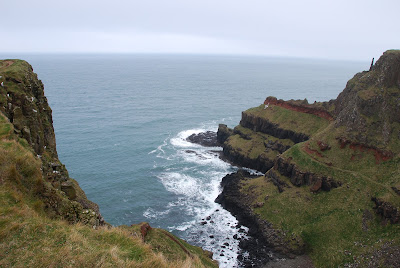Over the past couple of days I have been reflecting on stories we tell with our lives. As the time to leave leave Corrymeela and Northern Ireland draws closer, I am increasing aware of what has been written into this chapter of my life over the past three months. A big part of the story has been the many friends that came come into my life during this period - connections that I know will continue. The work of Corrymeela with young people of various ages has been a positive experience and something that causes me to think a great deal about the issues of healing and reconciliation in a place with such a long history of divisions and conflict. I have a new and more complete understanding of these issues. Seeing and experiencing Northern Ireland has given me more understanding of the history and beauty of this part of the world. The story continues and I look forward to sharing this with friends when I get home.
Good Craic
A consistent theme here over the past three months has been stories, laughter, humour and fun - there is much of it and it is good for the soul. The term used to describe these times is "craic." I remember the first time I was asked by one of the women here "what's the craic" I was at a loss for a response - something rare for me. I have heard many expressions and slang terms that were totally new to me and often confusing. I am less confused now and know what a number of these mean, but haven't really taken these up when speaking (at least not that I am aware of).
The Giant's Causeway
This UNESCO World Heritage Site is purported to be the largest tourist attraction in Northern Ireland. Located a short distance west of Ballycastle on the coast, the Giant's Causeway is an easy day trip from Corrymeela. The rock formations are impressive - an estimated 40,000 hexagonal columns of varying heights exist in and around the causeway. Without going into the long geological explanation, the patterns in the stones were the result of rock crystallization under conditions of accelerated cooling. This generally occurs when molten lava comes into immediate contact with water and the fast cooling caused we what we see today. (My friend Betsy the geologist would know a lot more about this.)
The geological explanation is good, but the best story about the Giant's Causeway is about Finn MacCool. Finn was renown warrior apparently going about his daily duties when one of his adversaries, a Scottish giant called Benandonner, starting shouting and ridiculing Finn's fighting prowess. This angered Finn and he took a clump of dirt and threw it over to Scotland to challenge the Scottish giant. In turn, Benandonner threw a stone back at Finn and yelling that he would make sure Finn would never fight again if he could get his hands on him.
Finn then proceeded to tear huge pieces off the cliffs and for over a week he pushed stones to make a causeway to Scotland. When finished, he yelled to the Scottish giant that he now had no excuse to not come and fight Finn. Tired from building the causeway, however, Finn did not feel like fighting right away and slept for a week as he needed some time to recuperate. He quickly made a large large cot and disguised himself as a baby and waited for Benandonner. Arriving at Finn's house, the Scot was told by Finn's wife that he was away, but asked the Scot to sit down and have a couple of tea. She also fed the Scot cake with stones in it making the Scottish giant think that Finn must be pretty tough to eat this cake. Benandonner noticed the baby in the cot and reached in his hand to touch the sleeping baby. The baby bit off one of the Scotsman's fingers. Shocked by this, Benandonner wondered to himself - if this is Finn's baby, what must his father be capable of. The thought terrified him and he ran back across the causeway to Scotland. I understand there are other versions of the story, but this seems to be the most common.
Here are some photos of the causeway stones and scenes in the surrounding area. Some of the pictures were taken from the cliffs above the causeway. Spectacular scenery!!



























